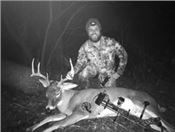|
Keep Hunting, But Have Deer Tested For CWD

Eric Michel, a former graduate student in the Mississippi State University Department of Wildlife, Fisheries and Aquaculture,
harvested this buck in Wisconsin in 2018. Days later, it tested positive for Chronic Wasting Disease.
Submitted photo
STARKVILLE, MISS.
For many of you, chronic wasting disease, or CWD, is old hat and you’re tired of hearing about it. I understand.
Keep in mind that if the consequences of this disease were not so dire, you would not continue to hear information about CWD from wildlife management experts. Below are a few issues I would like to address as we approach the winter months with deer season in full swing.
First, despite what you may have heard on social media, this disease kills deer. Research from other regions of the country where the disease has been in existence for decades is now showing deer population declines.
Is the effect of CWD in a deer population immediate? No, its not. This disease does not cause immediate deaths and population declines like other diseases you may have heard of, for example, blue tongue or epizootic hemorrhagic disease. Instead, the effects of CWD take years and even decades before the manifestation of the disease causes population declines.
Once a deer gets CWD, it can take six months and even up to two years before the deer succumbs to the neurodegenerative failure caused by the disease. During this time the deer may die from other causes – like vehicle collisions, predators, hunter harvest or diseases like pneumonia. Deer with CWD make not actually die from CWD, but the disease predisposes them to a host of other mortality factors.
Second, congregating deer in small areas will facilitate the spread of CWD. One of the mechanisms by which CWD can be spread is through saliva. So, it makes perfect sense that if deer are congregating around a food source, the opportunity for disease transmission is greater.
This is the reason our state wildlife agency, the Mississippi Department of Wildlife, Fisheries, and Parks, bans the use of supplemental feeding and baiting in CWD regions – to minimize the spread. Will abatement of feeding and baiting eliminate the spread of CWD? No, it will not. But this is a proactive measure we can take to lessen the degree and rate of spread.
Finally, I encourage each of you to have your deer tested. Routine feedback I get from hunters when I ask the question “did you have your deer tested last year?” is “the deer didn’t look sick.” Keep in mind what I mentioned earlier that this disease takes many months to get to a point where a deer will appear sick. For up to and beyond a year, the deer may look perfectly healthy, so please don’t assume your deer doesn’t have CWD.
Other feedback I get is “I didn’t know where to take the sample.” Please visit the MDWFP website where you will find the location of 36 locations throughout the state. What’s more, there’s videos showing you exactly how to take the sample and label it. Last year, there were very few samples submitted from the southern portion of the state, so I encourage hunters down south to find a drop off location near you. We need samples submitted from all over the state so we can get the best picture of where the disease occurs.
I don’t want this information to scare you and keep you from hunting. In fact, just the opposite. Please enjoy the great outdoors this fall and hunt and have fun. But be aware the state of Mississippi needs you to comply with the best management practices provided by MDWFP to slow the spread of CWD. ∆
|
|